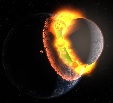|
Star/Galaxy movement
|
|
| Watsisname | Date: Saturday, 27.08.2016, 02:43 | Message # 16 |
 Galaxy Architect
Group: Global Moderators
 United States
United States
Messages: 2613
Status: Offline
| Yeah, the magnitude is quite amazing. In computer science it is always important to recognize the "order" of your algorithm to understand how efficient it is. Calculations of order N2 are really bad if N is big, like the number of stars in a galaxy. Thus the motivation for finding faster techniques.
Before doing this exercise I didn't know what the N2 result would actually end up being, but to find it takes >100,000 years to do one time-step on a standard home processor was humbling. "Longer to simulate than it takes the real thing to occur" is pretty bad if the real thing takes a billion years.  Which... put another way, gives an amazing impression of the computational power of the universe. Which... put another way, gives an amazing impression of the computational power of the universe.

|
| |
| |
| Alek | Date: Saturday, 27.08.2016, 05:25 | Message # 17 |
 Pioneer
Group: Users
 United States
United States
Messages: 326
Status: Offline
| Quote Watsisname (  ) Which... put another way, gives an amazing impression of the computational power of the universe.
This is "proof" that if our universe is just a computer simulation, this computer would have to be a very, very powerful machine...
Living among the stars, I find my way. I grow in strength through knowledge of the space I occupy, until I become the ruler of my own interstellar empire of sorts. Though The world was made for the day, I was made for the night, and thus, the universe itself is within my destiny.
|
| |
| |
| xdark_princex | Date: Saturday, 27.08.2016, 07:26 | Message # 18 |
|
Observer
Group: Users
 Pirate
Pirate
Messages: 14
Status: Offline
| LOL I only want to witness the destruction v.v and obviously no way I could witness it myself being of organic nature :P
Resistance Is Futile, You Will Be Assimilated.
|
| |
| |
| DoctorOfSpace | Date: Tuesday, 30.08.2016, 18:36 | Message # 19 |
 Galaxy Architect
Group: Global Moderators
 Pirate
Pirate
Messages: 3600
Status: Offline
| All discussions on simulation hypothesis and far future have been moved
Future of Humanity & Intelligent life in the universe
Intel Core i7-5820K 4.2GHz 6-Core Processor
G.Skill Ripjaws V Series 32GB (4 x 8GB) DDR4-2400 Memory
EVGA GTX 980 Ti SC 6GB
|
| |
| |
| parameciumkid | Date: Tuesday, 30.08.2016, 20:07 | Message # 20 |
 Explorer
Group: Users
 United States
United States
Messages: 277
Status: Offline
| Does the rotation of a galaxy model affect the positions of the stars in it?
Say I take a given galaxy and find some nice stars in it. If I proceed to change the rotation property of the entire galaxy and rotate it by one degree, will I find the same stars moved one degree around the center, or will the generator end up generating a completely different pattern of stars?
If it's the former, for now a simple "placeholder" form of star motion could be implemented by simply setting the rotations of galaxies based on the current universal time.
To those concerned about differences in orbital speeds, note that while dark matter appears to make outer stars move with a faster linear speed, their angular speed is not faster but rather about the same; excluding galactic cores, this basically makes galaxies appear to rotate like a rigid disc.
Intel HD Graphics 4000 ;P
|
| |
| |
| SpaceEngineer | Date: Wednesday, 31.08.2016, 21:19 | Message # 21 |
 Author of Space Engine
Group: Administrators
 Russian Federation
Russian Federation
Messages: 4800
Status: Offline
| Quote Alek (  ) This is "proof" that if our universe is just a computer simulation, this computer would have to be a very, very powerful machine...
Not necessary. It may be as powerful as 1970's calculator, but you can't detect it if your are in simulation. It's internal time tick (Plank time?) does not depend on computer speed. Although such slow computer must be able to work during quadrillions of years in it's universe to calculate one single femtosecond of our simulated universe...

|
| |
| |
| SpaceEngineer | Date: Wednesday, 31.08.2016, 21:22 | Message # 22 |
 Author of Space Engine
Group: Administrators
 Russian Federation
Russian Federation
Messages: 4800
Status: Offline
| Quote parameciumkid (  ) To those concerned about differences in orbital speeds, note that while dark matter appears to make outer stars move with a faster linear speed, their angular speed is not faster but rather about the same; excluding galactic cores, this basically makes galaxies appear to rotate like a rigid disc.
Yes, this is possible. But in real galaxies stars are wobbles over galactic plane, rotates around center on elliptical orbits, moved relative to each other and changes speed when entering the spiral arm. The galaxy itself changes it's spiral arms pattern. Modelling all of this is not possible. Also, all this occurred on time scale of millions of years, so SE needed global climate change simulation on planets, tectonics, simulation of orbital evolution, and evolution of the star.

|
| |
| |